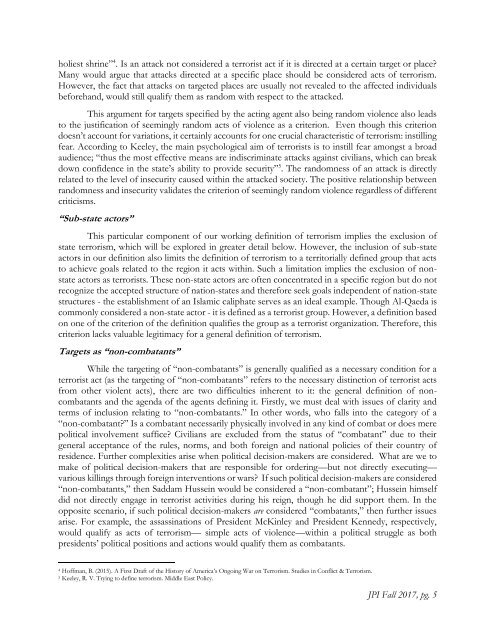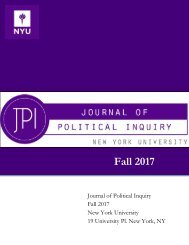JPI Spring 2018
Create successful ePaper yourself
Turn your PDF publications into a flip-book with our unique Google optimized e-Paper software.
holiest shrine” 4 . Is an attack not considered a terrorist act if it is directed at a certain target or place?<br />
Many would argue that attacks directed at a specific place should be considered acts of terrorism.<br />
However, the fact that attacks on targeted places are usually not revealed to the affected individuals<br />
beforehand, would still qualify them as random with respect to the attacked.<br />
This argument for targets specified by the acting agent also being random violence also leads<br />
to the justification of seemingly random acts of violence as a criterion. Even though this criterion<br />
doesn’t account for variations, it certainly accounts for one crucial characteristic of terrorism: instilling<br />
fear. According to Keeley, the main psychological aim of terrorists is to instill fear amongst a broad<br />
audience; “thus the most effective means are indiscriminate attacks against civilians, which can break<br />
down confidence in the state’s ability to provide security” 5 . The randomness of an attack is directly<br />
related to the level of insecurity caused within the attacked society. The positive relationship between<br />
randomness and insecurity validates the criterion of seemingly random violence regardless of different<br />
criticisms.<br />
“Sub-state actors”<br />
This particular component of our working definition of terrorism implies the exclusion of<br />
state terrorism, which will be explored in greater detail below. However, the inclusion of sub-state<br />
actors in our definition also limits the definition of terrorism to a territorially defined group that acts<br />
to achieve goals related to the region it acts within. Such a limitation implies the exclusion of nonstate<br />
actors as terrorists. These non-state actors are often concentrated in a specific region but do not<br />
recognize the accepted structure of nation-states and therefore seek goals independent of nation-state<br />
structures - the establishment of an Islamic caliphate serves as an ideal example. Though Al-Qaeda is<br />
commonly considered a non-state actor - it is defined as a terrorist group. However, a definition based<br />
on one of the criterion of the definition qualifies the group as a terrorist organization. Therefore, this<br />
criterion lacks valuable legitimacy for a general definition of terrorism.<br />
Targets as “non-combatants”<br />
While the targeting of “non-combatants” is generally qualified as a necessary condition for a<br />
terrorist act (as the targeting of “non-combatants” refers to the necessary distinction of terrorist acts<br />
from other violent acts), there are two difficulties inherent to it: the general definition of noncombatants<br />
and the agenda of the agents defining it. Firstly, we must deal with issues of clarity and<br />
terms of inclusion relating to “non-combatants.” In other words, who falls into the category of a<br />
“non-combatant?” Is a combatant necessarily physically involved in any kind of combat or does mere<br />
political involvement suffice? Civilians are excluded from the status of “combatant” due to their<br />
general acceptance of the rules, norms, and both foreign and national policies of their country of<br />
residence. Further complexities arise when political decision-makers are considered. What are we to<br />
make of political decision-makers that are responsible for ordering—but not directly executing—<br />
various killings through foreign interventions or wars? If such political decision-makers are considered<br />
“non-combatants,” then Saddam Hussein would be considered a “non-combatant”; Hussein himself<br />
did not directly engage in terrorist activities during his reign, though he did support them. In the<br />
opposite scenario, if such political decision-makers are considered “combatants,” then further issues<br />
arise. For example, the assassinations of President McKinley and President Kennedy, respectively,<br />
would qualify as acts of terrorism— simple acts of violence—within a political struggle as both<br />
presidents’ political positions and actions would qualify them as combatants.<br />
4<br />
Hoffman, B. (2015). A First Draft of the History of America’s Ongoing War on Terrorism. Studies in Conflict & Terrorism.<br />
5<br />
Keeley, R. V. Trying to define terrorism. Middle East Policy.<br />
<strong>JPI</strong> Fall 2017, pg. 5
















